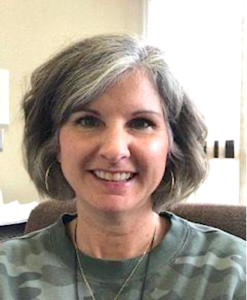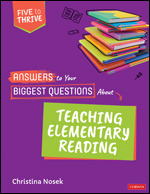Answers to Questions Reading Teachers Ask
Answers to Your Biggest Questions About Teaching Elementary Reading
By Christina Nosek
(Corwin Press 5 to Thrive series, 2022 – Learn more)
Reviewed by Pam Hamilton


There is not an indication of what grade levels this book is written for, but the examples and references are K-5. The author is a fifth grade teacher and she is the highlighted teacher in the grade 5 video examples.
Guiding Questions for Effective Teaching
The book is organized into five chapters that each start with a “guiding question” that the reader needs to address to get started in being an effective reading teacher:
- How Do I Build and Maintain a Reading Community?
- How Do I Structure, Organize, and Plan My Reading Instruction?
- What Are the Key Instructional Principles to Know and Use?
- How Do I Use Assessment in the Service of Students?
- How Do I Shift Agency to Students, Engaging and Empowering Them as Readers?
Each chapter also has 7-to-12 subquestions answered under the guiding question.
You can start at the beginning and read straight through the book, or read the chapters in any order, depending on what your most pressing need is.
A vignette of classroom life is presented at the beginning of each chapter to give real-world context to the guiding question. Then the chapter immediately goes into one of the subquestions for that chapter. These subquestions offer a chance for self-reflection that will allow you to examine your current practice.
My Favorite Finds
As an upper elementary educator, I particularly appreciate the subquestion “How Can I Make Reading Relevant for My Students?” In this section, Nosek addresses the topics of book access, personal identity, timeliness, varied reading material and authentic response.
“While books should not simply be discarded because of their age, they should be critically examined,” she writes. We can’t keep using the same books every year just because we already have a full classroom library, or “that’s what we’ve always done.” The author gives 5 excellent questions to ask when weeding books from our classroom libraries.
There are also “keys to equity,” “great resources,” “terms to know,” and “ideas to keep in mind” sprinkled throughout the chapters. These text features offer additional resources and reflections to aid in the continued learning that is the goal of this book. There are additional online resources available through a Corwin link listed in the front of the book.
Addressing the Reading Wars
Anyone familiar with teaching reading these days has no doubt heard something about the “Reading Wars.” Nosek does a great job of explaining what Balanced Literacy is and how it includes the foundational skills (phonemic awareness, phonics and fluency), as well as meaning making (vocabulary and comprehension), in varying instructional delivery modes. She then goes on to explain a bit about each of these components and how they look.
There’s an entire chapter on assessment and getting to know each of your readers’ individual strengths and areas of needed support using a multitude of methods of formative assessment. Knowing your reader is the best way to help them advance.
Setting Students Up for Reading Independence
Something else I really appreciate about this book is how everything is geared toward helping the student become responsible for their learning – setting them up for independence – especially important in the upper elementary/intermediate grades when we are preparing our students to enter middle school.
Answers to Your Biggest Questions About Teaching Elementary Reading helps you create conditions for students to build classroom communities, become collaborators, choose their own books, and, most importantly, fall in love with reading!
This is an excellent book to read from cover to cover the first time, and then to have on hand to refer back to as needs arise throughout the school year. It’s an easy read and would be great for your summer professional reading stack!
Pam Hamilton is an intermediate literacy coach in Middlebury, Indiana. She is a trained Reading Recovery teacher and has been in education for over 28 years. She enjoys working alongside teachers as they instill a love of literacy in their students.




































